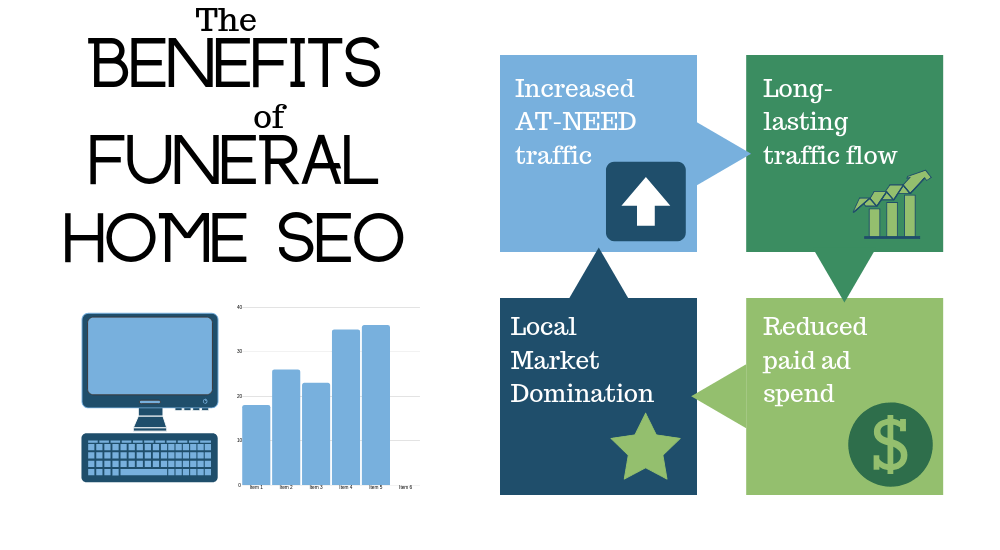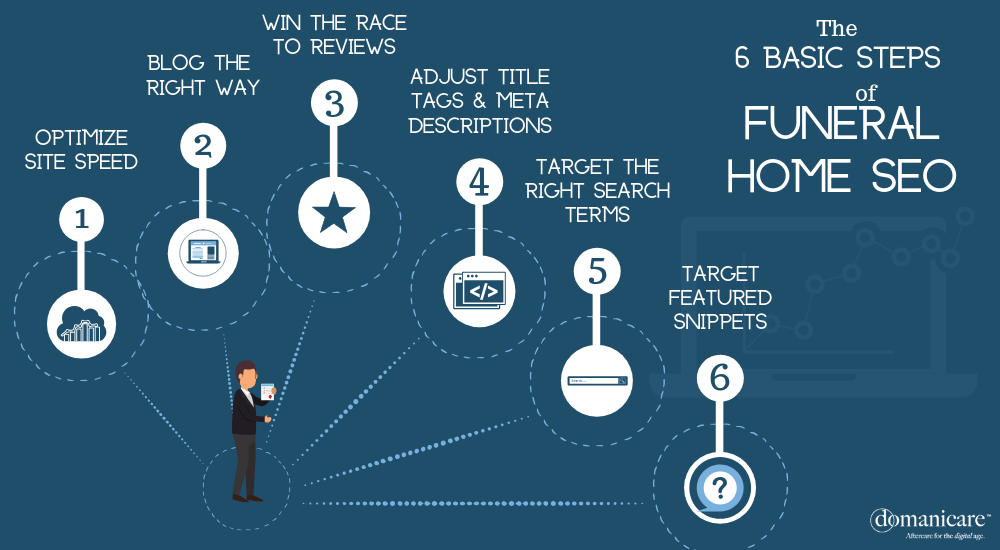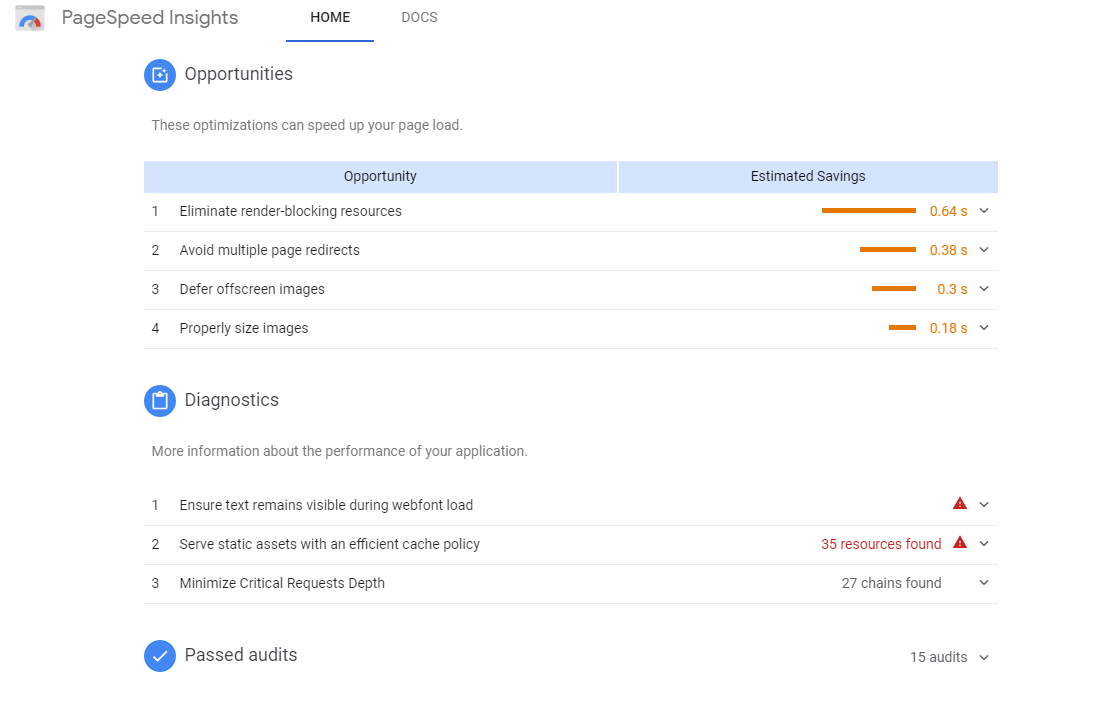The Funeral Professional's Guide to SEO
Chad Zollinger • April 12, 2019
Too many funeral professionals think that SEO means "have a blog." It's actually a bit more complicated than that.
In reality, blogging is the minimum effort in modern SEO — there is huge opportunity for funeral homes to generate at-need calls and preneed leads through search optimization.
Funeral homes will have a completely different experience than in other industries when trying to rank in Google. As a funeral home, you need an SEO strategy that is both cost effective and time effective.
An effective aftercare program
will actually help you increase your organic ranking by generating positive reviews, increase brand loyalty and exposure, and open up the door for backlink building.
Search engine optimization for funeral homes is easy if you know what you’re doing and are committed to winning the first SERP position.
That said, between technical optimizations, structured data, link building, and review generation, it’s easy to see why some funeral professionals can get lost in the technicalities.
This article is your roadmap for beginning a successful SEO strategy at your funeral home. If you follow these SEO tips for funeral homes, you will outrank your competition and generate more leads online.
Just follow these six simple steps to ensure your funeral home has a stronger online presence than your competitor:
- Optimize Your Site Speed
- Learn to Blog the Right Way
- Win the Reviews Race
- Adjust Your Title Tags and Meta Descriptions
- Target the Right Search Queries
- Target Featured Snippets
Optimize Your Site Speed
Slow site load speeds have two enormous negative impacts:
- Google uses page speed as a ranking determiner.
- 53% of all mobile web users "bounce" from sites that take longer than three seconds to load (Think With Google).
Creating a quick, seamless website will give your users a better experience on your site, leading to more leads, more sales, and more customers.
It will also increase the amount of total pages each individual user views on your website. The easier it is to get from one page to another, the more it will happen.
Curious to see if your website has slow site speed? There are plenty of site speed testers, but Google's is probably the most reliable (after all, they're the ones we're trying to impress). Just use Google's PageSpeed Insights
tool by inserting your site URL and wait for the tool to do its job.
The tool will then give your site a score for both mobile and desktop websites. Mobile sites are a bit trickier to optimize than desktop sites, so don't be surprised if your mobile site speed is slower than your desktop site speed.
As you can see below, Google will tell you exactly what needs to change on your site in order for it to load faster. Just make the suggested changes and you're good to go.
The vast majority of funeral home websites that have site speed issues are not properly optimizing images.
The process of optimizing images is very easy. Take all the images on your site and put them through an image optimizer tool like TinyPNG
or ImageOptimizer
(these tools are free so they aren't perfect).
If you want an extremely high quality image optimizer tool, I recommend Kraken.io. Its cheapest plan costs $5 per month and allows you to optimize 500 MB of images each month.
Blogging the Right Way
The three biggest mistakes small businesses (and funeral homes) make in their blogging efforts revolve around article length, article topic, and article optimization. Here’s what you need to know:
Article Length
SEO professionals
suggest that articles should be right around 1,900 words. However, since SEO isn’t practiced as aggressively in the funeral industry, the standard will be slightly lower.
The article length rule for the funeral industry: 1,500 words or at least double the length of your best competitor.
In reality, the length of the article doesn’t matter as much as the quality of what you write. If you write a 3,000-word article full of nonsense, it’s not going to rank very well.
On the other hand, the world’s most helpful 1,000-word article will rank on the first page in Google.
So do not become fixated on article length.
In the end, your article’s helpfulness and shareability will be the biggest determiner of success. It is much better to ask yourself “does this article completely answer my reader’s question?” than “have I written enough words?”
It is much better to ask yourself “does this article completely answer my reader’s question?” than “have I written enough words?” Click to Tweet
Article Topic
Your talent for choosing the right topic really depends on two things: how well you know your customers and how well you research keywords. I can’t help you get to know your customers better, but I can help you with keyword research.
Let’s start with the obvious: the most-searched keywords in the funeral industry are the shortest and most broad as far as topic. For example, according to Keywords Everywhere, the term “preneed funeral” is searched 320 times per month.
A less obvious, but equally important tip is that longer, more specific keywords are generally easier to rank for. The term “Preneed Funeral in Tulsa,” would be a great keyword for which to rank.
So, now you know that the article topic “How to Plan a Preneed Funeral in Tulsa” is a good article to write. In actuality, you are competing for multiple keywords and keyword strings by writing this article, including “preneed,” “preneed funeral,” “funeral,” “funeral in Tulsa,” etc.
If you need a tool to determine the estimated search traffic of a term, I suggest Keywords Everywhere, since it’s a free chrome/firefox extension. If you’re willing to invest more money into an SEO tool, I recommend Ahrefs, a multi-tool platform that equips you with all you need to beat your digital marketing competitors.
We've actually compiled a list of 101 funeral home blog articles
that would rank highly in Google. Check it out to start blogging the right way.
Article Optimization
Your article will not succeed by only writing long articles and choosing the right topic.
You need to make the article as accessible as possible — remember, article optimization is the process of making an article readable and accessible.
The first thing you should do when you finish an article is publicize it. There are three ways to publicize your work effectively:
- Send it out to previous contacts and ask them if they’d share it.
- Quote experts and ask them if they’d share it.
- Syndication
Every article you write should rely partly on the thoughts and findings of experts in your industry. You will find that industry experts are absolutely willing to provide a quote for your article, share it on social media, and in some cases, link to your article on their site.
You should also syndicate your article on sites like Medium. If you’d like to do a short excerpt and provide a link to the full article, that works just fine.
The next step is to make your article as shareable as possible. Every article that is published on your site should have social share buttons on it. Target the social media sites where your audience is most active (Facebook for older audiences, Twitter for younger audiences, Instagram for both).
Use ClicktoTweet
buttons within your article — these will increase the chances of readers sharing your article on their social channels.
One massively overlooked tactic is tone. The tone and voice of your article also contribute to its shareability.
People share when they feel that the article has explained something personal better than they could themselves; this means your voice needs to mirror or complement the voice of those reading your article.
It’s also important to note that you should post articles on your site at least once a week. Staying current will show Google that you mean business and that your site is a reliable source of information.
Win the Reviews Race
Google reviews do help you rank higher
in Google.
Not only are reviews vital for any small business, they are especially impactful in industries where reviews are normally hard to come by. In comparison to other industries, the funeral profession is an untapped goldmine.
A few negative reviews can completely obliterate your online presence. On the other hand, a handful of positive reviews can give you the upper hand over your competition — you’ll be able to tell the difference once you begin to receive calls from online sources.
So what’s the problem? Why are funeral homes struggling to get customer reviews?
The answer is that families are grieving and are too emotionally stressed to leave a review. An added complication is that funeral directors don’t want to ask families for reviews during their grieving process.
So how do you get positive reviews in the funeral industry?
Aftercare Review Generation
Domanicare’s text-message-based aftercare service can completely turn around your review generation efforts.
The truth is that families are much more than willing to leave reviews when funeral homes make conscious efforts to reach out and provide help to grieving families after the funeral.
An effective aftercare program will nurture a healthy emotional state in the funeral home customers. Our funeral home partners have discovered that a thorough, compassionate, and helpful aftercare program results in customers willing to leave highly positive reviews.
For example, a Domanicare partner, Clark Legacy Center, was able to generate 14 positive reviews in the first three days after using Domanicare. Their score improved from a 4.2 average star rating to a 4.7.
Storytelling Review Generation
Another great way to generate reviews for your funeral home is to harness the power of storytelling. The families you’ve helped in the past have powerful stories of healing that can help your other customers overcome their challenges and grief.
Invite your past customers to tell their stories on your site through video or blog format. This opens the door for you to request they also leave an honest review for your site on Google.
Title Tag and Meta Description Adjustments
Your title tag is what Google searchers see when they type in a search query.
For example, when I search “Best Funeral Homes,” the top sites have the title tags “Berg Mortuary - Provo” and “Best Funeral Homes in America.”
One of these title tags is much more optimized than the other.
Each page on your site should have a unique title tag. If you have a pricing page, you need to create a clickable title tag and optimize it for those searching “funeral home prices.”
There are four things you should keep in mind when optimizing for Google: Click-through rate, clicks, impressions, and page rank.
Clicks are the number of people who clicked on your site in Google.
Impressions are the number of people who saw your link in Google.
Click-through rate, or CTR, is the number of people who clicked your link compared to the number of people who saw your link.
Page rank is the position your page currently occupies for a specific search term.
When you optimize your title tag correctly, you may see higher page ranks and higher CTR rates. In other cases, you may see a higher page rank and higher impressions, but a lower CTR, which results in lower clicks.
The trick to title tag optimization is to create tags that customers are more likely to click on. So, targeting the click-through rate is a great way to increase the overall amount of users on your site.
Target the Right Search Queries
You know your audience.
As a funeral director, you speak with families every day about planning and paying for funerals — you know the questions they ask. All you have to do is format those questions for the internet.
Ask yourself how someone might search the questions they ask you everyday. For example, if you always get questions about cremation, are your potential customers more likely to search “what is cremation?,” “how much does cremation cost?,” or “what is the cremation process?”
Your gut instinct is usually the correct one. It’s important not to judge the search query solely off of total search traffic. You need to realistically judge whether or not you can actually win a first-page ranking for each keyword.
Afterall, it’s much better to rank on the first page for “funeral homes in New York” than to rank on the tenth page for “funerals.”
You can also use answerthepublic.com to research question variants on specific search terms.
Target Google's Featured Snippets
Featured snippets are also called position 0 on Google SERPs.
When you make a search query that many people have searched before, Google will find the best answer and place it right at the top of the page in a special snippet format.
Since this snippet is listed above the other results, it has been given the nickname “position 0.”
Featured snippets in the funeral profession tend to revolve around prices and cost (search “funeral cost” for an example), but there is definitely an opportunity for funeral homes to capitalize on the questions their customers always ask.
For example, there are large number of people looking for answers to questions like:
- How big is a casket?
- How do I plan a funeral?
- Can you finance a funeral?
- How long does it take to plan a funeral?
These are all good questions to answer in a how-to article. Keep in mind that to rank in position 0, you need to answer the search query better than any of your competitors — in other words, your answer must be clear and concise.
Another important thing to note is that when Google grants a search query a featured snippet, it’s a clue and an additional insight into what your audience is searching.
The fact that Google wants to provide a quick answer to a specific question means you’re on the right track.
Featured snippets are a hint of what we’ll be seeing in the future from Google. Google’s job is to get the answer as quickly as possible for internet users. Voice search will pull heavily from featured snippets and the sites that win the most featured snippets will benefit the most.
The Bottom Line
The question you need answered is this: how do I rank higher in Google?
Content marketers and SEO specialists can complicate the Google game unnecessarily — they’ll answer that question by saying on site optimizations, or thorough content campaigns, or article frequency, or technical SEO optimizations are the most important thing to focus on.
The truth is that all of it is important. But the answer to the question of ranking higher in Google comes down to your ability to help the users of your site.
And, luckily for funeral professionals, no one is better equipped to answer questions about the funeral industry than funeral home owners.
All you have to do is answer your customer’s questions completely, truthfully, and in a way they’ll instantly understand.
Google will see your value when your customers see your value.
Funeral Home Articles

If there's one thing we've learned in 2020, it's that it's difficult to predict the future, and there will all be surprises that lie ahead. Businesses and individuals need to stay agile and adaptable to be ready for whatever life throws at them. 2020 has been a challenging year for the funeral profession and others as well. Still, we've seen that those funeral homes and funeral professionals who have focused on making their consumer experience as comforting and easy as possible are those that are winning. At Domani, we exist to help funeral homes help their families have a better experience. Through the power of text messaging, we follow up with families and give them the support and resources they need following a loss. That great experience then leads to a positive online review and helps others looking for a positive experience to find that funeral home. It's a virtuous cycle that helps grow a funeral home's at-need business. When it comes to preneed, the same principle holds. If funeral homes can provide the experience a family is looking for, that will be the funeral home that wins. During 2020, our preneed appointment setting team has found great success in scheduling remote appointments. Funeral homes that have been willing to adapt and find new ways to do business have grown even during difficult circumstances. We firmly believe that technology will help us as a funeral profession provide those better experiences for families, but simply using technology for technology's sake is not the answer. We need to leverage technology to help provide personal, engaging experiences with families. We shouldn't use technology as a crutch or an excuse. It's another way to help the ones we serve and provide them the support they need during a difficult time. As we approach the end of the year and look forward to 2020, take some time to think about how your funeral home is providing meaningful experiences for families and how/what you can do to improve that in the coming year. If you're interested in learning more about Domanicare or Domani Appoinment Setting, please schedule a demo by clicking the link below.

By far the most effective way to create a sense of loyalty to your funeral home is to perform an exceptional service for that family. However, there’s more that you can be doing to establish credibility with families. Here’s three easy steps on how to develop loyalty to your company and ensure your customers come back for your services when a loved one passes.

The vast majority of people in the US and Canada use smartphones. Almost everyone has a smartphone nowadays. Remember when the first “smartphone” came out in 1992 and cell phones like the BlackBerry and iPhone were considered luxuries when they were first created? Now it’s a common sight to see an iPhone. Most funeral homes and cemeteries haven’t even scratched the surface of text-based aftercare, but with 80% of the U.S. population owning a smartphone, and that number expected to rapidly grow.


